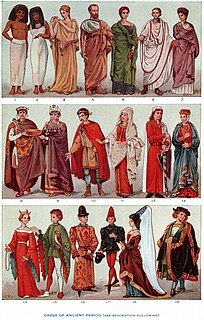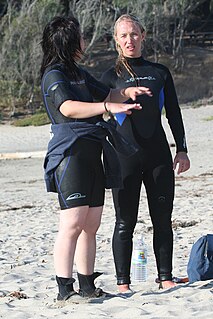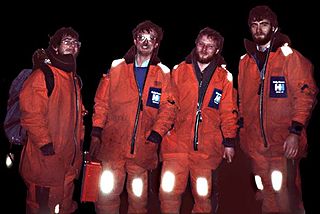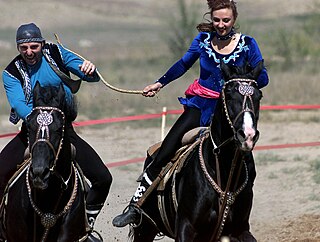
Clothing is items worn on the body. Clothing is typically made of fabrics or textiles but over time has included garments made from animal skin or other thin sheets of materials put together. The wearing of clothing is mostly restricted to human beings and is a feature of all human societies. The amount and type of clothing worn depends on gender, body type, social, and geographic considerations.

A leotard is a unisex skin-tight one-piece garment that covers the body from the crotch to the shoulder. The garment was first made famous by the French acrobatic performer Jules Léotard (1838–1870). There are sleeveless, short-sleeved and long-sleeved leotards. A variation is the unitard, which also covers the legs.

To improve motorcycle safety many countries mandate the wearing of personal protective equipment such as protective clothing and helmets. Protective clothing may include certain types of jackets, gloves, boots, and pants. Jackets meant for motorcyclists are typically made of leather or specialized man-made fabrics like cordura or Kevlar. These jackets typically include heavy padding on the elbow, spine, and shoulder regions. Gloves are generally made of leather or Kevlar and some include carbon fiber knuckle protection. Boots, especially those for sport riding, include reinforcement and plastic caps on the ankle and toe areas. Pants are usually leather, cordura, or Kevlar. Except for helmets, none of these items are required by law in any state in the USA, or in any part of the UK but are recommended by many of those who ride.

A wetsuit is a garment, usually made of foamed neoprene, which is worn by surfers, divers, windsurfers, canoeists, and others engaged in water sports and other activities in or on water, primarily providing thermal insulation, but also buoyancy and protection from abrasion, ultraviolet exposure and stings from marine organisms. The insulation properties depend on bubbles of gas enclosed within the material, which reduce its ability to conduct heat. The bubbles also give the wetsuit a low density, providing buoyancy in water.

A dry suit or drysuit provides the wearer with environmental protection by way of thermal insulation and exclusion of water, and is worn by divers, boaters, water sports enthusiasts, and others who work or play in or near cold or contaminated water. A dry suit normally protects the whole body except the head, hands, and possibly the feet. In hazmat configurations, however, all of these are covered as well.

Extreme cold weather clothing refers to clothing for arctic or mountainous areas. Its primary function is to trap air as an insulator to prevent heat loss from the wearer's body. Secondary and necessary is to conduct water vapor away from the body to keep the insulating layers dry. A shell keeps the wind from disturbing the still air in the insulating layers. In warmer conditions, the shell protects from water intrusion.

In the field of textiles, fishnet is hosiery with an open, diamond-shaped knit; it is most often used as a material for stockings, tights, or bodystockings. Fishnet is available in a multitude of colors, although it is most often sported in traditional matte black. Fishnet is commonly worn on the legs and arms by practitioners of goth and punk fashion, but is also commonly worn by the mainstream as a fashion statement. Generally considered to be a sexy garment, it may serve as a component of sexual fetishism. Fishnets are used mostly as a type of undergarment, and in as much as it defines curves by applying a grid close to the body it generally accentuates the wearer's muscular definition.

A ski suit is a suit made to be worn over the rest of the clothes when skiing or snowboarding. A ski suit made for more casual winter wear outdoors may also be called a snowsuit [ˈsnoʊˌsut] and are often used by children as everyday outerwear in the winter season. Some suits are specifically made for snowboarders but most are used by either skiers or snowboarders regardless of the style.

Sporting equipment, also called sporting goods, has various forms depending on the sport, but it is essential to complete the sport. The equipment ranges from balls, to nets, and to protective gear like helmets. Sporting equipment can be used as protective gear or as tool used to help the athletes play the sport. Over time, sporting equipment has evolved because sports have started to require more protective gear to prevent injuries. Sporting equipment may be found in any department store.
Clothing terminology comprises the names of individual garments and classes of garments, as well as the specialized vocabularies of the trades that have designed, manufactured, marketed and sold clothing over hundreds of years.

Helly Hansen is a Norwegian producer of textiles and gear for sports and work on the ocean and in the mountains, headquartered in Oslo, Norway. From its founding in 1877 until October 2009, the company was headquartered in Moss, Norway.

An undershirt is an article of underwear worn underneath a dress shirt intended to protect it from body sweat and odors. It can have short sleeves (T-shirt) or be sleeveless (A-shirt). The term most commonly refers to upper-body wear worn by males.

Bunker gear or turnout gear, also known as a fire kit in the UK and Ireland, are terms used by many firefighters to refer to their personal protective equipment (PPE). "Bunker gear" and "turnout gear" can refer, depending on the context, to just the trousers, boots and jacket, or to the entire combination of personal protective equipment and personal protective clothing. The terms are derived from the fact that the trousers and boots are traditionally kept by the firefighter's bunk at the fire station to be readily available for use. In Hong Kong, it is referred to as "incident gear".
Layered clothing is a term describing a way of dressing using many garments that are worn on top of each other. Some of the layers have different, largely non-overlapping, functions. Using more or fewer layers, or replacing one layer but not others, allows for flexible clothing to match the needs of each situation. Two thin layers can be warmer yet lighter than one thick layer, because the air trapped between layers serves as thermal insulation. Layered clothing is particularly relevant in cold climates, where clothing must at the same time transfer moisture, provide warmth, and protect from wind and rain. In a hot and dry climate, clothes have very different functional requirements: they must block the radiation from the sun, and allow for sufficient air circulation. Therefore, layered clothing in the sense used in this article is largely irrelevant in hot and dry climates. The wicking layer moves the sweat from your skin, where it can be absorbed by the other layers.

Sailing wear is a type of clothing for sailing. It protects the sailor from water and insulates the body on board a vessel.

Clothing fetishism or garment fetishism is a sexual fetish that revolves around a fixation upon a particular article or type of clothing, a particular fashion or uniform, or a person dressed in such a style.

Compression garments are pieces of clothing that fit tightly around the skin. In medical contexts, compression garments provide support for people who have to stand for long periods or have poor circulation. These come in varying degrees of compression, and higher degree compression sleeves, such as sleeves that provide compression of 20–30 mmHg or higher, typically require a doctor's prescription. Compression garments worn on the legs can help prevent deep vein thrombosis and reduce swelling, especially while traveling.
Nikwax Analogy is a two-component fabric system for weatherproof clothing based on "biomimicry" of fur.

Sportswear is an American fashion term originally used to describe separates, but which since the 1930s has come to be applied to day and evening fashions of varying degrees of formality that demonstrate a specific relaxed approach to their design, while remaining appropriate for a wide range of social occasions. The term is not necessarily synonymous with activewear, clothing designed specifically for participants in sporting pursuits. Although sports clothing was available from European haute couture houses and "sporty" garments were increasingly worn as everyday or informal wear, the early American sportswear designers were associated with ready-to-wear manufacturers. While most fashions in America in the early 20th century were directly copied from, or influenced heavily by Paris, American sportswear became a home-grown exception to this rule, and could be described as the American Look. Sportswear was designed to be easy to look after, with accessible fastenings that enabled a modern emancipated woman to dress herself without a maid's assistance.

Kazakh clothing, worn by the Kazakh people, is often made of materials suited to the region's extreme climate and the people's nomadic lifestyle. It is commonly decorated with elaborate ornaments made from bird beaks, animal horns, hooves and feet. Although contemporary Kazakhs usually wear Western dress, the Turkic people wear more traditional clothing for holidays and special occasions.


























